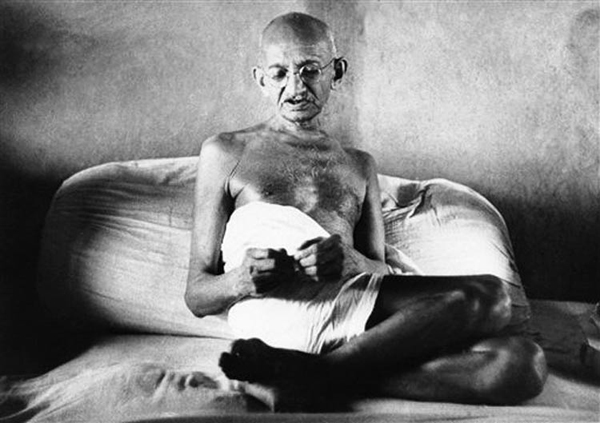
Some men changed their times...
One man changed the World for all times!
Comprehensive Website on the life and works of
Mahatma Gandhi
+91-23872061
+91-9022483828
info@mkgandhi.org

+91-23872061
+91-9022483828
info@mkgandhi.org
Gandhi's nonviolent approach |
- By Clifton B. Parker  Stanford's Saumitra Jha suggests that new evidence calls for a reinterpretation of Gandhi's nonviolent movement for independence in India. He explains how today's democratic movements can benefit by adopting lessons from India's independence movement and its iconic leader. The organizational innovations behind Mohandas Gandhi's nonviolent movement in India offer lessons for contemporary peace movements, a Stanford scholar argues. In a new paper that reinterprets Gandhi's legacy, Stanford's Saumitra Jha, an associate professor of political economy, examines the potential and pitfalls of nonviolent disobedience. His co-author is Rikhil Bhavnani, an assistant professor of political science at the University of Wisconsin-Madison. Too often, nonviolent civil disobedience fails, they wrote. "The key lesson of India's successful movement is sometimes reduced to the simple but rather unhelpful admonition, 'Find another Gandhi,' who can lead through individual charisma," Jha said in an interview. The truth is more complicated - and besides, India's independence movement took decades and experienced plenty of ups and downs, he added. For Jha and Bhavnani, this was fertile ground to study what worked and what did not. The scholars researched numerous data sources on India's independence movement, including voter turnout, intelligence reports, archival correspondence and records from both India and Britain. They also examined the effectiveness of 250 nonviolent and violent political campaigns globally between 1945 and 2006. The problem with movements that begin nonviolently is that they can be co-opted by people prone to exploit the short-term gains that violence offers, the two wrote. To overcome this, Gandhi mobilized followers across ethnic and societal lines, and elevated leaders and followers truly committed to nonviolent aims. Indian InnovationsTiming was also crucial, Jha said. The global Great Depression of the early 1930s gave impetus in India for political coalitions to be formed. Farmers and agriculturists were swayed to join with Gandhi's reformers in the Civil Disobedience Movement of 1930-1932, as it was known. This came in the wake of Gandhi's reforms of the Indian Congress in the 1920s that opened the political system to people who were committed to nonviolent objectives and tactics. "These organizational innovations took the (Indian) Congress movement from one dominated by a rich elite to one organized on the principle of self-sacrifice, selecting future leaders who could be trusted to maintain non-violent discipline in pursuit of the extension of broad rights and public policy objectives," Jha and Bhavnani wrote. This yielded results. The British finally decided to negotiate, and by 1936 allowed both local autonomy and the first broadly democratic elections in India, according to the researchers. It was also the people - leaders and members - who galvanized the peace movement and made it more successful than other campaigns, both in India and elsewhere, they said. "Addressing these challenges for sustaining a nonviolent movement requires identifying and mobilizing sufficient numbers of select potential followers that are willing to forgo temptations for violence in favor of national objectives," Jha and Bhvanani wrote. How did Gandhi find the right people? Jha said the iconic Indian leader's legendary requirements of "self-sacrifice" - for himself and his followers - were instrumental in separating out those who did not believe in peaceful resistance. Indeed, those who courted arrest for civil disobedience and faced hard labor in British jails revealed their trustworthiness and authenticity. Many veterans of India's jails subsequently advanced to leadership ranks. In contrast, the Indian independence movement lacked such fortitude at other times, according to Jha. For example, the British arrest of 60,000 Congress leaders in an overnight sweep in 1942 led to a rapid breakdown of nonviolent discipline. "Nowadays, Indian politicians also go to jail a lot, but for very different reasons than during the independence movement," said Jha, referring to the political corruption of today's India. Gandhi was especially astute in reorganizing the movement away from elite politics on one hand and religious zealotry and terror on the other. Instead of relying on the usual methods of political insurrection, he found another: self-sacrifice of an intensely personal kind. And in doing so, he and his followers revealed the strength of what happens when a mass mobilization is committed to nonviolent methods and big-picture public objectives. Broader applicabilityJha said Gandhi's lessons for reform are not India-specific - they offer lessons for freedom movements around the world. He and Bhavnani found that large nonviolent campaigns that exceed 500,000 members - while attracting intense international media attention - are likely to be most effective in achieving change. However, without organizations that maintain nonviolent discipline, such mass movements often turn violent, they said. Audiences are important, too. In the case of Gandhi, the international media, particularly in America, showed that coverage could impose costs on entities like Great Britain that might otherwise benefit from the violent repression of nonviolent movements. Jha and Bhavnani point to the intrinsic link between nonviolent movements and the success of new democracies. "Unlike leaders that condone violence and can thus punish others using violence, nonviolent leaders both need a mass movement to be successful as well as the consent of the movement's members," they wrote. And large-scale consent is the legitimacy upon which democracies are based. Jha said the research may help explain why nonviolent movements like India's have led to democratic consolidation, while democracies have often faltered in other places that lacked more enduring nonviolent commitments and leadership. Source: http://news.stanford.edu/news/2014/october/gandhi-peace-movements-10-29-2014.html |